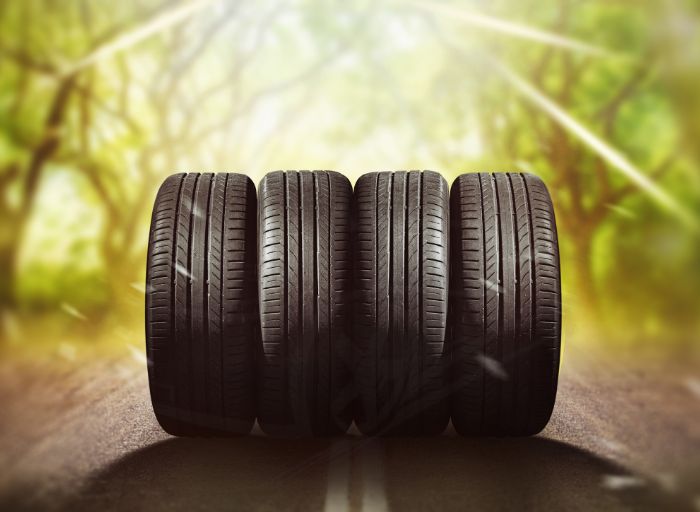
When spring finally arrives, it’s time to replace your winter tires with summer tires. Here you can find out why the change is so important when the best time is to put on summer tires and what characteristics a good summer tire should have.
Table of Contents
Why Should I Change to Summer Tires?
The demands that a tire must meet vary greatly depending on the outside temperature and the road surface. That is why summer and winter tires have different treads and rubber compounds. This is the only way to ensure that the tire has an optimum grip on the road.
There is no legal obligation to change to summer tires. Nevertheless, you should – depending on the weather – put on summer tires from around Easter because this is the only way to drive safely in summer. One of the reasons for this is the rubber compound of the tire. Winter tires have a much softer compound that is adapted to cold temperatures.

Summer temperatures, on the other hand, can cause damage to the tread of a winter tire, to the point where parts of the tread become detached. Especially when the car is more heavily loaded, it can break free in a dicey situation where a quick reaction is essential. The summer tire, on the other hand, gives the car grip and stability in any situation.
Shorter Braking Distance
When it comes to braking distance, the summer tire is also clearly ahead in warm temperatures. Various tire tests prove this: The winter tire has up to 16 meters longer braking distance in summer than the summer tire. This is an enormous distance, which in case of doubt, can mean the difference between life and death.
The braking distance was measured at 35°C outside temperature at a speed of 100 km/h. Certainly one of the most important advantages offered by summer tires.
Lower Fuel Consumption
What should convince all economy foxes to change tires is the significantly lower fuel consumption of the seasonally adapted tire. The harder rubber compound and lower rubber content in summer tires ensure that the tire can withstand much higher temperatures without becoming soft. Winter tires, on the other hand, wear out much faster at higher temperatures than summer tires. The right tire, therefore, has a much longer service life.
When Should Summer Tires Be Fitted?
From when should you put on summer tires? Again and again, you hear the rule: “From O to O!” This means that summer tires should be on the car from Easter to October. As a rule of thumb, the information is absolutely correct. You still have to pay a little attention to the weather because even around Easter, it may well snow again.
The right time to fit summer tires is therefore not determined by date but by the weather and road conditions. As a general rule, the performance of summer tires increases continuously from 7°C and above. At the latest, when the temperatures permanently exceed 15°C, the change is inevitable.
Summer Tires: Tread Depth, Air Pressure, and Other Properties
Summer tires differ from winter tires on the one hand by the different rubber compounds and on the other hand by the different profiles, which are adapted to the respective road conditions. Summer tires offer the best performance on dry and rain-soaked roads, both in handling and braking. This is due to the summer tire tread, which has larger tread blocks and many longitudinal grooves that perfectly channel water outward when it rains so that the tire is always in contact with the road. Unlike winter tires, summer tires have significantly fewer sipes. Instead, the tire’s softer rubber compound ensures perfect cornering and driving stability.
Tread depth
The recommended tread depth for summer tires is 2 mm, but it should never be less than the legal minimum tread depth of 1.6 mm, otherwise, there is no longer any reliable grip. The less tread there is, the longer the braking distance. On wet roads, there is also the risk of aquaplaning.
The right tire pressure
Most drivers are on the road with underinflated tires. In general, the tire pressure of summer tires should be about 0.2 bar lower than that of winter tires. The ideal summer tire pressure for your vehicle can be found in the car’s owner’s manual, a sticker in the gas cap flap, a sticker in the door or in the glove compartment.
This differs depending on the vehicle, load, type of car, and a few other factors. When you check the air pressure of your tires, they should be cold. Don’t forget the pressure of the spare tire, either. To be really safe, the tire pressure should be checked every two weeks.
Direction of travel
Most car tires have a running direction that must be observed. If the tire is mounted in the wrong running direction, this will manifest itself in high wear and heavy noise. In addition, you would have to deal with worsened driving behavior.
The running direction is often recognizable by an arrow or another indication on the sidewall of the tire. Especially if you like to drive fast, you should stick to the prescribed running direction. As the noise of your tires plays an important role with usability and comfort, it’s vital that you pay attention to these kinds of details.
Conclusion
The change from winter tires to summer tires is worthwhile in any case. You benefit from a shorter braking distance, lower fuel consumption and drive much safer. You can rely on your summer tires, especially in curves, on wet roads, or in dicey situations.
Hi there! I’m Naomi O’Colman. I’ve got years of experience working at an auto repair shop here in Texas under my belt. On top of that, ever since I was a kid I’ve been passionate about the auto industry. Since I’ve joined the team at automotivegearz.com I’ve been enthusiastically sharing my passion and insights with my readers. I’m dedicated to delivering high quality content and helping you stay up to date with the latest automotive trends and products out there!







